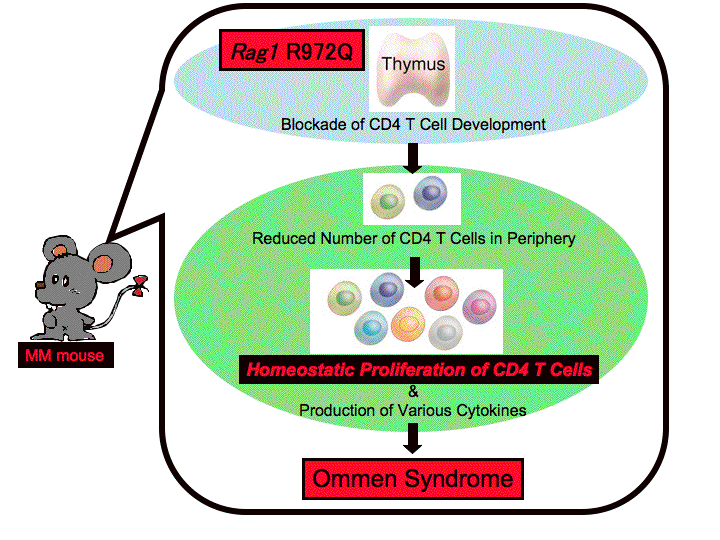ADDRESSJST-CREST 2-1, Yamada-oka Suita, Osaka 565-0871, Japan TEL:81-6-6879-4856 Masaaki Murakami, Ph.D., D.V.M. |
AchievementsMM mouse is a murine model of Omenn Syndrome and has excess homeostatic proliferating CD4 T cells, which play a role for the pathogenesis. MM mouse having a hypomorphic point mutation in Rag1 gene was discovered from a C57BL/10 colony. We found that T cell development in thymus was partially blocked and peripheral T cell numbers decreased in the mutant. It is known that patients with Omenn Syndrome also have hypomorphic RAG mutations and develop varying manifestations of severe combined immunodeficiency. MM mouse contains high numbers of memory-phenotype CD4 and CD8 T cells and experienced hepatosplenomegaly and eosinophilia, had oligoclonal T cells, and demonstrated elevated levels of IgE, major symptoms of Omenn Syndrome. In periphery of MM mouse, T cells are proliferating more compared to control animals by homeostatic proliferation induced by a lymphopenic condition of the mutant. Homeostatic proliferating CD4 T cells in MM mouse produce various cytokines, including IL-4 and IL6 etc. Depletion of CD4 T cells from the MM mouse recovered from a hyper IgE concentration in serum, which is a critical differential diagnosis of Omenn Syndrome from non-T/non-B SCID. Moreover, all double mutant MM mice that were crossed with IL-4KO, IL-6KO, and CD40LKO recovered from the hyper IgE. Thus, these results demonstrated that homeostatically proliferating CD4 T cells are critically involved in the pathogenesis of the Omenn Syndrome. *Khiong, K., *M. Murakami, C. Kitabayashi, N. Ueda, S. Sawa, A. Sakamoto, B. L. Kotzin, S. J. Rozzo, K. Ishihara, M. Verella-Garcia, J. Kappler, P. Marrack, and T. Hirano. (*equal contribution). Homeostatic proliferating CD4 T cells are involved in the pathogenesis of an Omenn syndrome murine model. J. Clin. Invest. 117: 1270-1281, 2007(PubMed) (Full text of JCI) (Commentary in JCI) (Research Highlights in Nature Immunology) (Research Highlight in Nature Reviews Immunology)
|
|
Copyright © 2007 Osaka University all rights reserved.
|
|
